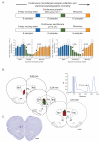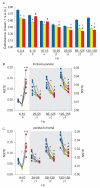Neural Correlates of Wakefulness, Sleep, and General Anesthesia: An Experimental Study in Rat
- PMID: 27617688
- PMCID: PMC5069172
- DOI: 10.1097/ALN.0000000000001342
Neural Correlates of Wakefulness, Sleep, and General Anesthesia: An Experimental Study in Rat
Abstract
Background: Significant advances have been made in our understanding of subcortical processes related to anesthetic- and sleep-induced unconsciousness, but the associated changes in cortical connectivity and cortical neurochemistry have yet to be fully clarified.
Methods: Male Sprague-Dawley rats were instrumented for simultaneous measurement of cortical acetylcholine and electroencephalographic indices of corticocortical connectivity-coherence and symbolic transfer entropy-before, during, and after general anesthesia (propofol, n = 11; sevoflurane, n = 13). In another group of rats (n = 7), these electroencephalographic indices were analyzed during wakefulness, slow wave sleep (SWS), and rapid eye movement (REM) sleep.
Results: Compared to wakefulness, anesthetic-induced unconsciousness was characterized by a significant decrease in cortical acetylcholine that recovered to preanesthesia levels during recovery wakefulness. Corticocortical coherence and frontal-parietal symbolic transfer entropy in high γ band (85 to 155 Hz) were decreased during anesthetic-induced unconsciousness and returned to preanesthesia levels during recovery wakefulness. Sleep-wake states showed a state-dependent change in coherence and transfer entropy in high γ bandwidth, which correlated with behavioral arousal: high during wakefulness, low during SWS, and lowest during REM sleep. By contrast, frontal-parietal θ connectivity during sleep-wake states was not correlated with behavioral arousal but showed an association with well-established changes in cortical acetylcholine: high during wakefulness and REM sleep and low during SWS.
Conclusions: Corticocortical coherence and frontal-parietal connectivity in high γ bandwidth correlates with behavioral arousal and is not mediated by cholinergic mechanisms, while θ connectivity correlates with cortical acetylcholine levels.
Figures




Comment in
-
Integration and Information: Anesthetic Unconsciousness Finds a New Bandwidth.Anesthesiology. 2016 Nov;125(5):832-834. doi: 10.1097/ALN.0000000000001344. Anesthesiology. 2016. PMID: 27617691 No abstract available.
References
-
- Boveroux P, Vanhaudenhuyse A, Bruno MA, Noirhomme Q, Lauwick S, Luxen A, Degueldre C, Plenevaux A, Schnakers C, Phillips C, Brichant JF, Bonhomme V, Maquet P, Greicius MD, Laureys S, Boly M. Breakdown of within- and between-network resting state functional magnetic resonance imaging connectivity during propofol-induced loss of consciousness. Anesthesiology. 2010;113:1038–53. - PubMed
-
- Casali AG, Gosseries O, Rosanova M, Boly M, Sarasso S, Casali KR, Casarotto S, Bruno MA, Laureys S, Tononi G, Massimini M. A theoretically based index of consciousness independent of sensory processing and behavior. Sci Transl Med. 2013;5:198ra05. - PubMed
MeSH terms
Substances
Grants and funding
LinkOut - more resources
Full Text Sources
Other Literature Sources

